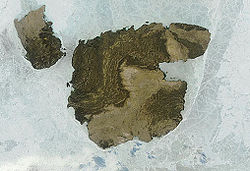 Mackenzie King Island with Brock and Borden Island | |
 | |
| Geography | |
|---|---|
| Location | Northern Canada |
| Coordinates | 78°02′N109°50′W / 78.033°N 109.833°W [1] |
| Archipelago | Queen Elizabeth Islands Arctic Archipelago |
| Area | 5,048 km2 (1,949 sq mi) |
| Length | 61 mi (98 km) |
| Width | 60 mi (100 km) |
| Highest elevation | 112 m (367 ft) |
| Administration | |
Canada | |
| Territory | Northwest Territories Nunavut |
| Demographics | |
| Population | 0 |
Mackenzie King Island is one of the uninhabited Queen Elizabeth Islands in northern Canada. It lies north of Melville Island and south of Borden Island, and like them is divided when it comes to administration. Most of the island is in Northwest Territories, while its easternmost portion lies in Nunavut. The border runs along the 110th meridian west.
Contents
Mackenzie King has an area of 5,048 km2 (1,949 sq mi), 60 miles (97 km) long in northeast or 47 miles (76 km) in southeast and 60 miles (97 km) wide, making it the 116th largest island in the world, and Canada's 26th largest island.



